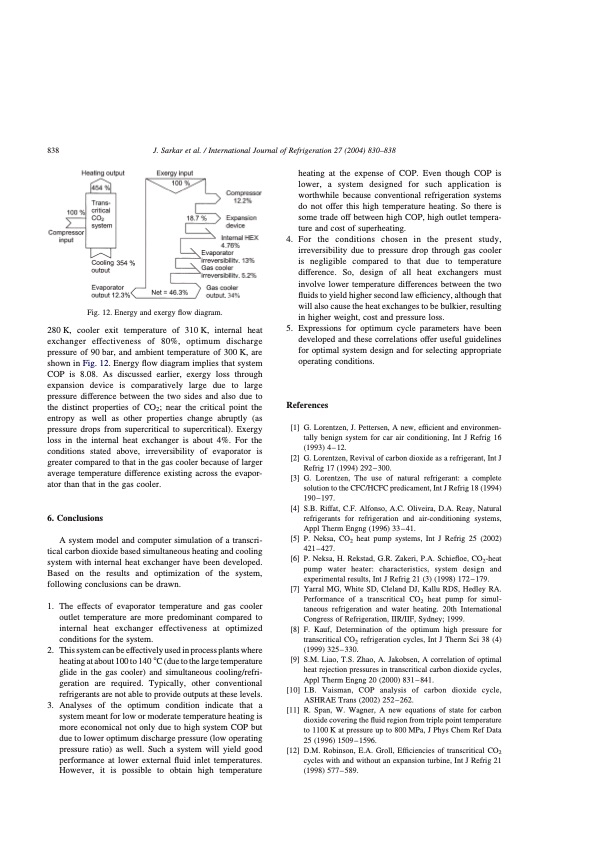
PDF Publication Title:
Text from PDF Page: 009
838 J. Sarkar et al. / International Journal of Refrigeration 27 (2004) 830–838 Fig. 12. Energy and exergy flow diagram. heating at the expense of COP. Even though COP is lower, a system designed for such application is worthwhile because conventional refrigeration systems do not offer this high temperature heating. So there is some trade off between high COP, high outlet tempera- ture and cost of superheating. 4. For the conditions chosen in the present study, irreversibility due to pressure drop through gas cooler is negligible compared to that due to temperature difference. So, design of all heat exchangers must involve lower temperature differences between the two fluids to yield higher second law efficiency, although that will also cause the heat exchanges to be bulkier, resulting in higher weight, cost and pressure loss. 5. Expressions for optimum cycle parameters have been developed and these correlations offer useful guidelines for optimal system design and for selecting appropriate operating conditions. References [1] G. Lorentzen, J. Pettersen, A new, efficient and environmen- tally benign system for car air conditioning, Int J Refrig 16 (1993) 4–12. [2] G. Lorentzen, Revival of carbon dioxide as a refrigerant, Int J Refrig 17 (1994) 292–300. [3] G. Lorentzen, The use of natural refrigerant: a complete solution to the CFC/HCFC predicament, Int J Refrig 18 (1994) 190 – 197. [4] S.B. Riffat, C.F. Alfonso, A.C. Oliveira, D.A. Reay, Natural refrigerants for refrigeration and air-conditioning systems, Appl Therm Engng (1996) 33–41. [5] P. Neksa, CO2 heat pump systems, Int J Refrig 25 (2002) 421 – 427. [6] P. Neksa, H. Rekstad, G.R. Zakeri, P.A. Schiefloe, CO2-heat pump water heater: characteristics, system design and experimental results, Int J Refrig 21 (3) (1998) 172–179. [7] Yarral MG, White SD, Cleland DJ, Kallu RDS, Hedley RA. Performance of a transcritical CO2 heat pump for simul- taneous refrigeration and water heating. 20th International Congress of Refrigeration, IIR/IIF, Sydney; 1999. [8] F. Kauf, Determination of the optimum high pressure for transcritical CO2 refrigeration cycles, Int J Therm Sci 38 (4) (1999) 325 – 330. [9] S.M. Liao, T.S. Zhao, A. Jakobsen, A correlation of optimal heat rejection pressures in transcritical carbon dioxide cycles, Appl Therm Engng 20 (2000) 831–841. [10] I.B. Vaisman, COP analysis of carbon dioxide cycle, ASHRAE Trans (2002) 252–262. [11] R. Span, W. Wagner, A new equations of state for carbon dioxide covering the fluid region from triple point temperature to 1100 K at pressure up to 800 MPa, J Phys Chem Ref Data 25 (1996) 1509–1596. [12] D.M. Robinson, E.A. Groll, Efficiencies of transcritical CO2 cycles with and without an expansion turbine, Int J Refrig 21 (1998) 577 – 589. 280K, cooler exit temperature of 310K, internal heat exchanger effectiveness of 80%, optimum discharge pressure of 90 bar, and ambient temperature of 300 K, are shown in Fig. 12. Energy flow diagram implies that system COP is 8.08. As discussed earlier, exergy loss through expansion device is comparatively large due to large pressure difference between the two sides and also due to the distinct properties of CO2; near the critical point the entropy as well as other properties change abruptly (as pressure drops from supercritical to supercritical). Exergy loss in the internal heat exchanger is about 4%. For the conditions stated above, irreversibility of evaporator is greater compared to that in the gas cooler because of larger average temperature difference existing across the evapor- ator than that in the gas cooler. 6. Conclusions A system model and computer simulation of a transcri- tical carbon dioxide based simultaneous heating and cooling system with internal heat exchanger have been developed. Based on the results and optimization of the system, following conclusions can be drawn. 1. The effects of evaporator temperature and gas cooler outlet temperature are more predominant compared to internal heat exchanger effectiveness at optimized conditions for the system. 2. This system can be effectively used in process plants where heating at about 100 to 140 8C (due to the large temperature glide in the gas cooler) and simultaneous cooling/refri- geration are required. Typically, other conventional refrigerants are not able to provide outputs at these levels. 3. Analyses of the optimum condition indicate that a system meant for low or moderate temperature heating is more economical not only due to high system COP but due to lower optimum discharge pressure (low operating pressure ratio) as well. Such a system will yield good performance at lower external fluid inlet temperatures. However, it is possible to obtain high temperaturePDF Image | Optimization of a transcritical CO2 heat pump cycle

PDF Search Title:
Optimization of a transcritical CO2 heat pump cycleOriginal File Name Searched:
transcritical-co2-heat-pump.pdfDIY PDF Search: Google It | Yahoo | Bing
CO2 Organic Rankine Cycle Experimenter Platform The supercritical CO2 phase change system is both a heat pump and organic rankine cycle which can be used for those purposes and as a supercritical extractor for advanced subcritical and supercritical extraction technology. Uses include producing nanoparticles, precious metal CO2 extraction, lithium battery recycling, and other applications... More Info
Heat Pumps CO2 ORC Heat Pump System Platform More Info
| CONTACT TEL: 608-238-6001 Email: greg@infinityturbine.com | RSS | AMP |